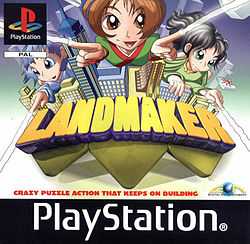LandMaker
| LandMaker Builder's Block | |
|---|---|
 European game cover | |
| Developer(s) | Taito Corporation |
| Publisher(s) |
|
| Distributor(s) |
|
| Platform(s) | Arcade, PlayStation, PlayStation Network |
| Release date(s) | Arcade
|
| Genre(s) | Puzzle |
| Mode(s) | Single-player |
| Distribution | CD-ROM |
LandMaker (ランドメーカー) is an arcade and PlayStation puzzle video game developed by the Taito Corporation. The arcade version was released only in Japan, while the PlayStation version was released in the US by Jaleco under the title Builder's Block and in Europe by Eon Digital Entertainment and Japan by Taito Corporation under its original name. The game was distributed on the PlayStation Network in Japan by Square Enix.[1]
The PlayStation version features three modes, which are puzzle, battle and arcade. The arcade mode (a direct port of the arcade version) is set in 2D with eight playable characters (Hiryu, a red-skinned man who is fire-based; Aifa, a young girl who is plant-based; Soumei, a pale man who is ice-based, Renki, a frightening purple-skinned man who seems to be based on mud, Youen, a female musician who seems to be based on Sound; Kouko, a muscular man who is rock-based; Rinrei, a blue-haired woman who seems to be sword-based and Roushinshi, an elegant-looking man that travels with a young boy, who is lightning-based.) while the battle modes are set in 3D. The objective of the game is to shoot a certain coloured block to other blocks of the same colour to create a building. The larger the building the greater damage that is done to the player's opponent which in effect speeds up the moving counter which pushes the blocks ever closer to the edge after which the player or opponent will lose the battle. The game is fast paced on all modes except puzzle which involves more strategy.
References
- ↑ Sony staff. "Land Maker" (in Japanese). Sony Computer Entertainment. Retrieved April 24, 2012.